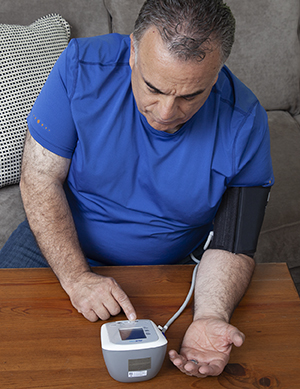Metabolic Syndrome: Lowering Your Blood Pressure
Metabolic syndrome is a set of 5 health factors that can lead to serious health problems. The factors greatly increase your risk for diabetes, heart attack, or stroke. High blood pressure (hypertension) is one of the factors of metabolic syndrome.
What is high blood pressure?
High blood pressure is when the force of blood against the inside of your blood vessels is higher than it should be. This makes your heart work harder. And it may damage your blood vessels. High blood pressure means a level of 130/80 mm Hg or more.
Your healthcare provider will often check your blood pressure each time you have an office visit. Having a high reading at one office visit does not mean that you have high blood pressure. High blood pressure means that your blood pressure is high over a period of time. That is why your provider checks it at each office visit. He or she can then look at the pattern of your blood pressure. Try to arrive early enough to your appointment so you can rest before your blood pressure is taken. Don't do any strenuous exercise, don't have caffeine, and don't smoke for at least 30 minutes before your pressure is measured. You can also check your own blood pressure at home. This helps to be sure it stays in good control.

Making lifestyle changes
Lifestyle changes can help lower your blood pressure. These changes can include:
-
Losing weight. Even a small amount of weight loss can lower your blood pressure. As you slowly lose weight, you may see your blood pressure slowly get lower.
-
Quitting smoking. The nicotine in tobacco raises blood pressure. Smoking also raises the risk for other heart and blood vessel diseases, many cancers, and most lung conditions. The first step is to set a quit date. Talk with your healthcare provider about ways to quit smoking. There are programs and medicines that can help.
-
Eating healthy. Eat plenty of fruits and vegetables. Eat fat-free or low-fat dairy foods, and drink less alcohol.
-
Eating less salt (sodium). Salt can raise blood pressure. Try salt-free seasoning, or herbs and spices. Choose low-salt or no-salt snacks, deli meats, and canned foods.
-
Being more physically active. Physical activity can help lower blood pressure. Get at least 30 minutes of activity on most days. If you are not very active, talk with your provider before you get started. They can help you figure out what is best for you.
-
Managing stress. Stress can raise blood pressure. Talk with your provider about lowering your stress level. They may advise relaxation methods, a counselor, health coach, or class.
Taking medicine
Your healthcare provider may also prescribe medicine to help lower your blood pressure. The medicine will help reduce the strain on your heart and help to protect your blood vessels. If you lose weight, you may be able to take less medicine. Or you may no longer need to take it. But, even if you lose weight and feel better, don't adjust your medicines or stop taking them unless you talk to your doctor
Online Medical Reviewer:
Marianne Fraser MSN RN
Online Medical Reviewer:
Raymond Kent Turley BSN MSN RN
Online Medical Reviewer:
Robert Hurd MD
Date Last Reviewed:
2/1/2022
© 2000-2024 The StayWell Company, LLC. All rights reserved. This information is not intended as a substitute for professional medical care. Always follow your healthcare professional's instructions.